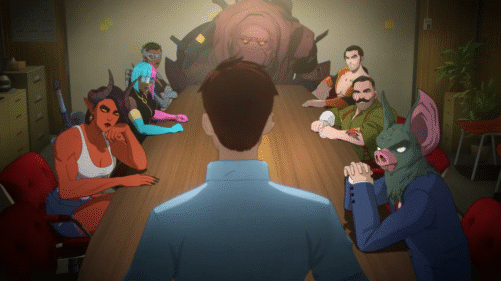It’s a funny thing, writing about video games for a publication named after Roger Ebert, who famously claimed video games would never be as artistically worthy as movies or literature (though he famously walked back that sentiment, if only a bit, months later). I wonder what he’d think of “Immortality”—the latest from Sam Barlow, who previously built similar interactive-movie mysteries like “Her Story” and “Telling Lies.” It’s a game, of sorts: There’s an interactive component, gameplay mechanics (innovative ones, at that), and you have the freedom to go where you will within the game’s world. But it’s also mostly a film, or a series of films, rather, playing off the film genres and eras Roger loved so much.
“Immortality” takes the framework of a video archive of footage involving the missing actress Marissa Marcel (a mesmerizing breakout turn from Manon Gage), whose career gleamed with the potential of major stardom before she mysteriously disappeared in 1999. She only ever shot three films, none of which were finished or released: The 1968 religious thriller “Ambrosio,” the 1970 erotic drama “Minsky,” and the Lynchian showbiz potboiler “Two of Everything” in 1999 (right at the moment of her disappearance from public life). Her vanishing remains a mystery, cultivating a morbid interest from film fans and Hollywood obsessives.
This leads to the database you see before you—a nearly 300-clip collection of raw footage from the filming of all three movies, as well as interviews, auditions, rehearsal footage, and other supplementary materials. This is the fertile ground upon which Barlow wants you to walk, scanning through the material with the Moviola-style program he gives you to figure out what happened to Marissa.
Before you’re halfway through the game’s tutorial, the program glitches, and suddenly you only have a single clip to work from—a leering interview spot with a Johnny Carson-like talk show host, set after the release of “Ambrosio” but during the shooting of “Minsky.” No matter, for the program has an innovative match-cut feature that will unlock new clips for you. Click on Marissa’s face, “Immortality” zooms in and zooms back out to another clip that features her. Click on not-Carson’s mug, you flip to a clip where another mug is featured. Rinse, repeat, further down the rabbit hole you go.
And so you go, opening up the archives of Marissa’s tragically short career one match cut at a time. It’s a disorienting experience, but deliberately so. You’re following a trail of breadcrumbs scattered throughout decades, moving from take to take as you mentally clock where the clip you’re watching fits in the Swiss-cheesed narrative of Marissa’s life. Unlike traditional video games, much of the gameplay comes in the act of watching and engaging with what’s on screen: forming connections, analyzing the text and subtext of scenes, stitching together narratives from broken fragments of celluloid. You’re film critic, editor, and archivist all in one.

It’s a game tailor-made for cinephiles, Barlow brilliantly replicating the look and feel of three different eras of film history. His “Ambrosio” is a gauzy, Expressionistic take on Ken Russell’s “The Devils,” here directed by a rotund martinet clearly modeled after Alfred Hitchcock (John Earl Robinson’s delightfully sleazy Andrew Fischer) and produced by an imperious Dino de Laurentiis type. “Minsky” has the air of Alan J. Pakula’s “Klute,” a bohemian art thriller that revels in its clash between ‘60s conservatism and ‘70s sexual liberation, and features Marissa as a Jane Fonda-like femme fatale, complete with that iconic shag haircut.
“Two of Everything” is harder to pin down, but it most closely mirrors Lynch’s “Mulholland Drive,” with its surreal story of a pop star’s body double impersonating her employer (both played by Marissa) and the tragedy that follows. Precise, meticulous thought went into emulating the cinematography, set design, costumes, and even performance style of each era, and it’s a feast for those familiar with the styles the game is echoing.
There are effectively three layers of story you’re uncovering in “Immortality.” The first, and most surface-level, is the plot of each of these films: “Ambrosio”’s tale of religious hypocrisy and inescapable lust, “Minsky”’s jaundiced cycle of art, murder, and obsession, “Two of Everything”’s take on the increasingly artificial nature of fame and celebrity.
But read between the lines, in the stolen moments before “action” and “cut,” and the real story of Marissa Marcel unfolds itself. It’s a story of Hollywood misogyny, of the way young women are chewed up and spit out by a male-dominated system that uses their enthusiasm and creativity for its own sexual and artistic gratification. In Marissa’s audition tape, she’s condescendingly mocked by Fischer for her apparent girl-next-door innocence; in a behind-the-scenes interview, Marissa’s asked how she feels about being “sculpted” by Fischer, with the director’s hand ominously resting on the back of her neck. You see the furtive affair she begins with John Durick (Hans Christopher), the DP of “Ambrosio,” who’d later become her director and most frequent creative partner on her other two films. He’s outwardly more loving but clearly using her for his artistic ends; conversely, she sees potential in the younger filmmaker after working with a veteran of the old school (Fischer) who’s past his peak. This twisted creative partnership unravels in unorthodox ways as they entangle themselves behind the scenes with Marissa’s “Minsky” co-star, Carl Greenwood (Ty Molbak)—a Greek tragedy that ends with the predictable pop of violence.

It’s striking to watch this in such close proximity to Andrew Dominik’s “Blonde,” another tale of Hollywood predation centered around a fictionalized, brutalized Marilyn Monroe. For my money, “Immortality” has far more to say about the voyeuristic nature of the film camera and the leering male eyes that look through it. We watch Marissa in various states of vulnerability and undress (sex and nudity are major components of the first two films, in particular), sometimes encouraged by Marissa but inevitably colored by the power dynamics of the men she works with. In so doing, we understand the carnivorous way Fischer and Durick look at Marissa and see it reflected in ourselves. As our eyes scan footage of her frame-by-frame, or you click on an exposed breast to match-cut to another scene of the same, it’s hard not to feel complicit in that same consumption.
And Barlow, much like Dominik in “Blonde,” is hardly immune from criticism on that front. Whether Marilyn or Marissa, both figures revel in the transgressive nudity of their subjects under the guise of critiquing the male gaze that hungers for it so ravenously.
Beware: major spoilers for a fundamental layer of “Immortality“’s gameplay follows.
But what makes “Immortality” more elusive (and consequently more gripping) is that aforementioned third layer, which lies beyond the thin veneer of celluloid that separates reality from the movies. It’s subtle at first, that low, bassy thrum that plays over specific stretches of footage. Stop the tape and roll it back slowly, and something akin to a jump scare comes; where Marissa stood, you see a mysterious woman (a haunting, revelatory Charlotta Mohlin) in her place, slinking through the frame like a serpent. Her words are enigmatic and spare but speak volumes, especially as you apply the same trick to more and more clips, uncovering the darker, anguished side of Marissa’s life as an artist.
Is she something supernatural, the living embodiment of the Greek muses? Is she the metaphorical expression of Marissa’s sublimated frustrations about the artistic process and her place in it? Blissfully, this element of the game makes room for both interpretations.

Through Mohlin’s staggering performance, anchored with centuries of pain and hurt, comes “Immortality”’s most beautiful moments. This culminates (for me, at least, you can view the proceedings in whatever order you like) in a gut-punch lip-sync of Lou Reed’s “Candy Says”—a mournful love song about transgender woman Candy Darling, one of Andy Warhol’s “superstars” (a figure who himself floats in the periphery of Marissa’s New York artist world).
It’s here that “Immortality” opens itself up to its most hopeful sentiments, elevating itself from a lurid tragedy of an abused Hollywood star to a recognition that everything, even the pain, becomes beautiful when transformed into art. There, no man can touch you, no bullet can wound. When your image is captured on film, you become something new—you’re forever young, part of something, a contributor to the collective creativity of mankind. Art makes you eternal, immortal. And, in the hands of a sufficiently engaged viewer, it can even bring you back to life.
One of Roger’s frequent laments about video games was that their non-linear, options-heavy nature devalued the journey you were meant to take. “Art seeks to lead you to an inevitable conclusion, not a smorgasbord of choices,” he once told Clive Barker at a conference where he tried to proselytize for the medium’s value. To its credit, “Immortality”’s conclusion is inevitable, if hardly conclusive; the game of it comes in your own journey toward that end, which never veers along the same path from player to player.
But isn’t that the way with a good film, or any other form of art? We start at the same beginning and end, but our paths to understanding differ depending on how we watch it. We may not even reach the same conclusions. “Immortality” emulates that thrill of engaging with a transformative piece of art and coming out changed on the other side. Look deep enough through the screen, and it might just look back at you. And when you walk out of the theater, a piece of it walks out with you.












